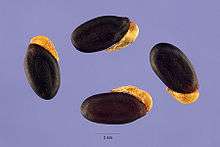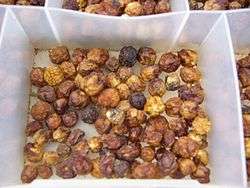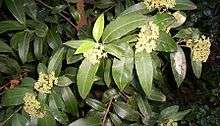Bush tucker

Bush tucker, also called bushfood, is any food native to Australia and used as sustenance by the original inhabitants, the Aboriginal Australians, but it can also describe any native fauna or flora used for culinary and/or medicinal purposes, regardless of the continent or culture. Examples of Australian native animal foods (meats) include kangaroo, emu and crocodile. In particular, kangaroo is quite common and can be found in Australian supermarkets, often cheaper than beef. Other animals, for example goanna and witchetty grubs, were eaten by Aboriginal Australians. Fish and shellfish are culinary features of the Australian coastal communities.
Examples of Australian native plant foods include the fruits quandong, kutjera, muntries, riberry, Davidson's plum, and finger lime. Native spices include lemon myrtle, mountain pepper, and aniseed myrtle. A popular leafy vegetable is warrigal greens. Nuts include bunya nut, and the most identifiable bush tucker plant harvested and sold in large-scale commercial quantities is the macadamia nut. Knowledge of Aboriginal uses of fungi is meagre but beefsteak fungus and native "bread" (a fungus also), were certainly eaten.
Traditional Aboriginal use
Aboriginal Australians have eaten native animal and plant foods for an estimated 60,000 years of human habitation on the Australian continent (see Indigenous Australian food groups, Australian Aboriginal sweet foods). Various traditional methods of processing and cooking are used. Toxic seeds, such as Cycas media and Moreton Bay chestnut, are processed to remove the toxins and render them safe to eat. Many foods are also baked in the hot campfire coals, or baked for several hours in ground ovens. "Paperbark", the bark of Melaleuca species, is widely used for wrapping food placed in ground ovens. Bush bread was made by males using many types of seeds, nuts and corns to process a flour or dough to make bread.
Aboriginal traditional native food use has been severely impacted by non-indigenous immigration since 1788, especially in the more densely colonised areas of south-eastern Australia. There, the introduction of non-native foods to Aboriginals has resulted in an almost complete abandonment of native foods by Aboriginals. This impact on traditional foods has been further accentuated by the loss of traditional lands which has resulted in reduced access to native foods by Aboriginals and destruction of native habitat for agriculture.
The recent recognition of the nutritional and gourmet value of native foods by non-indigenous Australians is introducing native cuisine to many for the first time. However, there are unresolved intellectual property issues associated with the commercialisation of bush tucker.
Colonial use
Bush tucker provided a source of nutrition to the non-indigenous colonial settlers, often supplementing meager rations. However, bushfoods were often considered to be inferior by colonists unfamiliar with the new land's food ingredients, generally preferring familiar foods from their homelands.
In the 19th century English botanist, J.D. Hooker, writing of Australian plants in Flora of Tasmania, remarked although "eatable," are not "fit to eat". In 1889, botanist Joseph Maiden reiterated this sentiment with the comment on native food plants "nothing to boast of as eatables."[1] The first monograph to be published on the flora of Australia reported the lack of edible plants on the first page, where it presented Billardiera scandens as, "... almost the only wild eatable fruit of the country".[2]
This became the accepted view of Australian native food plants until the late 20th Century. It is thought that these early assessments were a result of encountering strong flavours not generally suitable for out-of-hand eating, but these strong flavours are now highly regarded for culinary use.
The only Australian native plant food developed and cropped on a large scale is the macadamia nut, with the first small-scale commercial plantation being planted in Australia in the 1880s. Subsequently, Hawaii was where the macadamia was commercially developed to its greatest extent from stock imported from Australia.
Modern use
In the 1970s non-indigenous Australians began to recognise the previously overlooked native Australian foods. Textbooks like Wildfoods in Australia by the botanist couple Cribb & Cribb were popular. In the late 1970s horticulturists started to assess native food-plants for commercial use and cultivation.
In 1980 South Australia legalised the sale of kangaroo meat for human consumption. Analysis showed that a variety of bushfoods were exceptionally nutritious.[3] In the mid-1980s several Sydney restaurants began using native Australian ingredients in recipes more familiar to non-indigenous tastes – providing the first opportunity for bushfoods to be tried by non-indigenous Australians on a serious gourmet level. This led to the realisation that many strongly flavoured native food plants have spice-like qualities.
Following popular TV programs on "bush tucker", a surge in interest in the late 1980s saw the publication of books like Bushfood: Aboriginal Food and Herbal Medicine by Jennifer Isaacs, The Bushfood Handbook and Uniquely Australian by Vic Cherikoff, and Wild Food Plants of Australia by Tim Low.
Bush tucker ingredients were initially harvested from the wild, but cultivated sources have become increasingly important to provide sustainable supplies for a growing market, with some Aboriginal communities also involved in the supply chain. However, despite the industry being founded on Aboriginal knowledge of the plants, Aboriginal participation in the commercial sale of bush tucker is currently still marginal, and mostly at the supply end of value chains. Organisations are working to increase Aboriginal participation in the bush tucker market. Gourmet style processed food and dried food have been developed for the domestic and export markets.
The term "bushfood" is one of several terms describing native Australian food, evolving from the older-style "bush tucker" which was used in the 1970s and 1980s.
Media
TV shows made use of the bush tucker theme. Malcolm Douglas was one of the first presenters to show how to 'live off the land' in the Australian Outback. Major Les Hiddins, a retired Australian Army soldier popularised the idea of bush tucker as an interesting food resource. He presented a hit TV series called The Bush Tucker Man on the ABC TV network in the late 1980s. In the series, Hiddins demonstrated his research for NORFORCE in identifying foods which might sustain or augment army forces in the northern Australian Outback. 'NORFORCE' is a Regional Force Surveillance Unit of the Australian Army Reserve.
In early 2003, the first cooking show featuring authentic Australian foods and called Dining Downunder was produced by Vic Cherikoff and Bailey Park Productions of Toronto, Canada. This was followed by the Special Broadcasting Service (SBS) production of Message Stick with Aboriginal chef, Mark Olive.
Ray Mears recently made a survival television series called Ray Mears Goes Walkabout which focused on the history of survival in Australia, with a focus on bush tucker. In the series, Les Hiddins was a guest in one episode, with the two men sharing their knowledge and discussing various aspects of bush tucker.
In the TV survival series "Survivorman" host and narrator, Les Stroud, spend time in the Australian outback, after successfully finding and eating a witchetty grub raw he found many more and cooked them, stating they were much better cooked. After cooking in hot embers of his fire, he removed the head and the hind of the grub and squeezed out thick yellow liquid before eating.
Native Australian food-plants listed by culinary province and plant part
Australian bush tucker plants can be divided into several distinct and large regional culinary provinces. Please note, some species listed grow across several climatic boundaries.
Top-end
Monsoonal zone of the Northern Territory, Cape York and North-western Australia.
Fruits
| Adansonia gregorii | Boab |
| Buchanania arborescens | |
| Citrus gracilis | Kakadu Lime |
| Eugenia carissoides | Cedar Bay Cherry |
| Ficus racemosa | Cluster Fig |
| Manilkara kaukii | Wongi |
| Melastoma affine | Blue Tongue |
| Mimusops elengi | Tanjong |
| Morinda citrifolia | Great Morinda |
| Physalis minima | Native Gooseberry |
| Terminalia ferdinandiana | Kakadu Plum |
| Syzygium erythrocalyx | Johnstone's River Satinash |
| Syzygium fibrosum | Fibrous Satinash |
| Syzygium suborbiculare | Lady Apple |
Vegetables
| Dioscorea alata | Purple yam |
| Dioscorea bulbifera | Round yam |
| Dioscorea transversa | Pencil yam, Long yam |
| Eleocharis spp. | Spikerush |
| Ipomoea aquatica | Water spinach |
| Nelumbo nucifera | lotus |
| Nymphaea macrosperma | water lily |
Nuts
| Cycas media | Cycad palm seeds (Require detoxification: see Bush bread ) |
| Semecarpus australiensis | Australian Cashew |
| Terminalia catappa | Sea Almond |
Spices
| Eucalyptus staigeriana | Lemon Ironbark |
| Melaleuca leucadendra | Weeping Paperbark |
| Melaleuca viridiflora | Kitcha-kontoo |
| Ocimum tenuiflorum | Native Basil |
Outback Australia
Arid and semi-arid zones of the low rainfall interior.
Fruits
| Capparis spp. | Native Caper, Caperbush |
| Capparis mitchelii | Wild orange |
| Capparis spinosa subsp. nummularia | Wild passionfruit |
| Carissa lanceolata | Bush plum, Conkerberry |
| Citrus glauca | Desert Lime |
| Enchylaena tomentosa | Ruby Saltbush |
| Ficus platypoda | Desert Fig |
| Marsdenia australis | Doubah, Bush Banana |
| Owenia acidula | Emu Apple |
| Santalum acuminatum | Quandong, Desert or Sweet Quandong |
| Santalum murrayanum | Bitter Quandong |
| Solanum centrale | Akudjura, Australian Desert Raisin, Bush tomato |
| Solanum cleistogarnum | Bush tomato |
| Solanum ellipticum | Bush tomato |
Vegetables
| Calandrinia balonensis | Parakeelya |
| Ipomoea costata | Bush potato |
| Vigna lanceolata | Pencil Yam |
| Lepidium spp. | Peppercresses |
| Portulaca intraterranea | Large Pigweed |
Seeds
| Acacia aneura | Mulga |
| Acacia colei | |
| Acacia coriacea | Dogwood |
| Acacia holosericea | Strap Wattle |
| Acacia kempeana | Witchetty Bush |
| Acacia murrayana | |
| Acacia pycnantha | |
| Acacia retinodes | |
| Acacia tetragonophylla | Dead finish seed |
| Acacia victoriae | Gundabluey, Prickly wattle |
| Brachychiton populneus | Kurrajong |
| Panicum decompositum | native millet |
| Portulaca oleracea | Pigweed |
| Triodia spp. | commonly known as spinifex |
Spices
| Eucalyptus polybractea | Blue-leaved Mallee |
Insects in gall
Eastern Australia
Subtropical rainforests of New South Wales to the wet tropics of Northern Queensland.
Fruit
| Acronychia acidula | Lemon Aspen |
| Acronychia oblongifolia | White Aspen |
| Antidesma bunius | Herbet River Cherry |
| Archirhodomyrtus beckleri | Rose Myrtle |
| Austromyrtus dulcis | Midyim |
| Carpobrotus glaucescens | Pigface |
| Citrus australasica | Finger Lime |
| Citrus australis | Dooja |
| Davidsonia jerseyana | New South Wales Davidson's Plum |
| Davidsonia johnsonii | Smooth Davidsonia |
| Davidsonia pruriens | North Queensland Davidson's Plum |
| Diploglottis campbellii | Small-leaf Tamarind |
| Eupomatia laurina | Bolwarra |
| Ficus coronata | Sandpaper Fig |
| Melodorum leichhardtii | Zig Zag Vine |
| Pleiogynium timoriense | Burdekin Plum |
| Podocarpus elatus | Illawarra Plum |
| Planchonella australis | Black Apple |
| Rubus moluccanus | Broad-leaf Bramble |
| Rubus probus | Atherton Raspberry |
| Rubus rosifolius | Rose-leaf Bramble |
| Syzygium australe | Brush Cherry |
| Syzygium luehmannii | Riberry |
| Syzygium paniculatum | Magenta Lilly Pilly |
| Ximenia americana | Yellow Plum |
Vegetable
| Apium prostratum | Sea Celery |
| Commelina cyanea | Scurvy Weed |
| Geitonoplesium cymosum | Scrambling Lily |
| Tetragonia tetragonoides | Warrigal Greens |
| Trachymene incisa | Wild Parsnip |
| Urtica incisa | Scrub Nettle |
Spices
| Alpinia caerulea | Native Ginger |
| Backhousia citriodora | Lemon Myrtle |
| Backhousia myrtifolia | Cinnamon Myrtle |
| Leptospermum liversidgei | Lemon Tea-tree |
| Prostanthera incisa | Cut-leaf Mintbush |
| Smilax glyciphylla | Sweet Sarsaparilla |
| Syzygium anisatum | Aniseed Myrtle |
| Tasmannia stipitata | Dorrigo pepper (leaf and pepperberry) |
Nut
| Araucaria bidwillii | Bunya Nut |
| Athertonia diversifolia | Atherton Almond |
| Macadamia integrifolia | Macadamia Nut |
| Macadamia tetraphylla | Bush Nut |
| Sterculia quadrifida | Peanut Tree |
Temperate Australia
Warm and cool temperate zones of southern Australia, including Tasmania, South Australia, Victoria and the highlands of New South Wales.
Fruit
| Acrotriche depressa | Native Currant |
| Billardiera cymosa | Sweet Apple-berry |
| Billardiera longiflora | Purple Apple-berry |
| Billardiera scandens | Common Apple-berry |
| Carpobrotus rossii | Karkalla |
| Exocarpus cupressiformis | Native Cherry |
| Gaultheria hispida | Snow Berry |
| Kunzea pomifera | Muntries |
| Rubus parvifolius | Pink-flowered Native Raspberry |
| Sambucus gaudichaudiana | White Elderberry |
Seed

| Acacia longifolia | Golden Rods |
| Acacia sophorae | Coast Wattle |
Spice
| Eucalyptus dives | Peppermint Gum |
| Eucalyptus olida | Strawberry Gum |
| Eucalyptus globulus | Tasmanian Blue Gum |
| Mentha australis | River Mint |
| Prostanthera rotundifolia | Native Thyme |
| Tasmannia lanceolata | Mountain pepper |
| Tasmannia stipitata | Dorrigo Pepper |
Vegetable
| Apium insulare | Flinders Island Celery |
| Atriplex cinerea | Grey Saltbush |
| Burchardia umbellata | Milkmaids |
| Eustrephus latifolius | Wombat berry |
| Microseris lanceolata | Murnong |
See also
- Australian Aboriginal sweet foods
- Bush bread
- Bushfood industry history
- Bushmeat
- Bush medicine
- Damper (food)
- Indigenous Australian food groups
- Country food (equivalent term in Canada)
References
Footnotes
- ↑ Maiden, J.H., The Useful Native Plants of Australia, 1889, p.1
- ↑ Smith, J E (1793). Spec. Bot. New Holland. James Sowerby.
AMID all the beauty and variety which the vegetable productions of New Holland display in such profusion, there has not yet been discovered a proportionable degree of usefulness to mankind, at least with respect to food.
- ↑ Low, T., Wild Food Plants of Australia, Angus & Robertson, 1992, pp 199–202 ISBN 0-207-16930-6
Notations
- Bruneteau, Jean-Paul, Tukka, Real Australian Food, ISBN 0-207-18966-8.
- Cherikoff, Vic, The Bushfood Handbook, ISBN 0-646-15496-6.
- Isaacs, Jennifer, Bushfood, Weldons, Sydney.
- Kersh, Jennice and Raymond, Edna's Table, ISBN 0-7336-0539-7.
- Low, Tim, Wild Food Plants of Australia, ISBN 978-0-207-14383-0
External links
- Bush Tucker in the northern Tropics of Australia
- Popular Native Foods from Australian Flavour
- www.indigenousaustralia.info – The Travel Around Company
- Australian Bushfood and Native Medicine Forum
- Australian Bushfood Recipes
- Aboriginal women's knowledge
- CSIRO plant profiles
- Site of an industry pioneer
- Bushfoods Magazine
- Eat Australia
- Desert Knowledge Cooperative Research Centre
- Australian Bush Survival website with book recommendations
.jpg)





